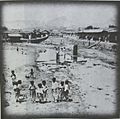Cheonggyecheon facts for kids
| Cheonggyecheon | |

Cheonggye Stream in downtown Seoul
|
|
Quick facts for kids Korean name |
|
|---|---|
| Hangul |
청계천
|
| Hanja | |
| Revised Romanization | Cheonggyecheon |
| McCune–Reischauer | Ch'ŏnggyech'ŏn |
Cheonggyecheon is a famous stream that flows right through the middle of Seoul, South Korea. It's about 5.84 kilometers (3.6 miles) long. This stream is special because it was once a dirty, covered-up river, but it was brought back to life!
For many years, Cheonggyecheon was hidden under concrete and even had a highway built over it. But after a huge effort, it was restored and reopened in 2005. Now, it's a beautiful ecological park where people can relax and enjoy nature. The restoration took three years and cost around $400 million. Since it reopened, many people visit Cheonggyecheon with their friends and family. Fun events are often held there too!
Contents
The Stream's Long History
Cheonggyecheon has a very long and interesting history. It was originally called 'Gaecheon,' which means 'open stream.' Before Seoul became the capital city during the the Joseon Dynasty, Cheonggyecheon was a natural stream.
Early Days and Floods
Sometimes, the stream would flood, covering houses and causing problems. Other times, it would become very dirty with standing water. To fix this, King Taejong, the third king of the Joseon Dynasty, started working on the stream. He began building channels to control the water.
Later, King Yeongjo, the 21st king, did a major overhaul. He had the stream dredged (cleaned out) and built strong stone banks along its sides. He even changed the path of the stream to make it straighter. Kings King Sunjo and King Kojong also continued to improve the stream. In those days, there were 24 bridges crossing the stream, though now there are 22.
During Japanese Rule
Around 1914, during the time Japan ruled Korea, the stream began to be called "Cheonggye," which is what we call it today. There were plans to clean and improve the stream as part of modern city planning. However, these plans didn't happen because there wasn't enough money. So, the stream remained neglected.
Covering the Stream
By 1945, after Korea became independent from Japan, Cheonggyecheon was very polluted. It was filled with trash from small houses built nearby and smelled bad. The stream became a big problem for Seoul's appearance and cleanliness. The easiest solution seemed to be covering it up with concrete.
So, in 1958, work began to cover the stream. By 1971, a long, wide elevated highway was built right over the stream. It was 5.6 kilometers (3.5 miles) long and 16 meters (52 feet) wide.
Bringing the Stream Back to Life
About 40 years after it was covered, the city of Seoul decided to bring Cheonggyecheon back. In July 2003, a huge recovery project began. After spending $386 million, Cheonggyecheon was reborn in September 2005. It became a beautiful place for people to walk and for wildlife to thrive.
Images for kids
See also
 In Spanish: Cheonggyecheon para niños
In Spanish: Cheonggyecheon para niños










